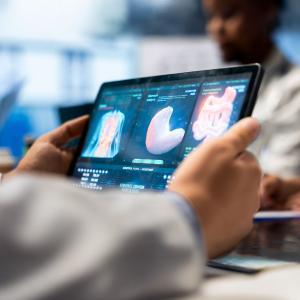NYU Langone Health Debuts the First Video Radiology Reports in a U.S. Hospital to Help Patients Understand the Results of Their Imaging Exams

A surface rendering of the kidneys, ureters, and bladder, at left, is made transparent in the image at right to show kidney stones in the right kidney and left ureter.
Image Courtesy of NYU Langone Department of Radiology
If you don’t know who your radiologist is, you’re not alone. A survey by the American College of Radiology showed that at least 50 percent of patients couldn’t name their radiologist and didn’t realize that they were a physician. If you don’t know what your radiologist does, you’re in good company. The same study found that many patients weren’t able to differentiate between the technologist who takes the images and the medical specialist who interprets them. If you can’t understand your radiology report, welcome to the club. Some 60 percent of patients find the technical language so opaque that it defies comprehension, according to a study published in the Journal of the American Medical Association.
For patients at NYU Langone Health, all that is about to change. Michael P. Recht, MD, chair of the Department of Radiology, is on a mission to demystify this field of medicine and revolutionize how patients learn the key findings of their imaging exams. “Traditionally, radiologists have provided static written reports so full of medical jargon that they’re extremely difficult for patients to decipher,” notes Dr. Recht, the Louis Marx Professor of Radiology at NYU Grossman School of Medicine. “The goal is to develop a new and better delivery method, and to take a more active role in patient-centered care.”
After seeing his children so absorbed by TikTok videos, Dr. Recht had a brainstorm. He envisioned short videos in which the radiologist would walk a patient through key imaging results using language free of jargon to describe the findings.
The idea capitalizes on milestone legislation, the 21st Century Cures Act, enacted in April 2021, that requires health systems to make certain categories of clinical notes, including imaging narratives, available to patients through their electronic medical records. “When everybody’s using videos to communicate, why are we still communicating the same way we did 100 years ago?” he thought. “As radiologists, we look at images. So why can’t we find a way to communicate with patients using images?”
VIDEO: An NYU Langone radiologist explains the key findings of an MRI of the knee.
Last year, 1.6 million patients used NYU Langone Health MyChart, NYU Langone’s electronic health record system, to view their radiology reports, prepared by clinical radiologists who make up the lion’s share of the department’s 250 faculty members. To explore the feasibility of a video version, Dr. Recht launched a pilot study in September 2021. Assembling a team led by neuroradiologist Matthew G. Young, DO, he issued a dual mandate: Create a patient-centered video reporting tool that combines easy-to-understand language from a radiologist and clearly annotated images, and then determine its impact on the patient experience.
In collaboration with two external technology partners, Visage Imaging GmbH and Siemens Healthineers, Dr. Young and several colleagues devised a prototype that could be integrated into NYU Langone’s Picture Archiving and Communication System, which radiologists use to read imaging studies, and delivered into NYU Langone Health MyChart for viewing by patients.
During the course of the study, 105 radiologists produced 3,763 video reports. Their findings were published on April 20, 2022, online in the American Journal of Roentgenology. In a related survey, the video reports earned high praise from patients and referring clinicians alike. “I understood everything the doctor was explaining, and the video made it perfectly clear,” says one grateful patient. “It was very interesting to see the inside of my body in that way. I actually learned something new.”
One of the team’s biggest challenges was to develop a streamlined production process that would not unduly burden radiologists. Depending on the subspecialty, on a daily basis a clinical radiologist typically reads 30 to 40 CT or MRI scans, 100 screening mammograms, or 150 to 200 X-rays. During the study, radiologists were able to create a video report in less than 4 minutes, but that time frame has since been trimmed to about 30 seconds, thanks in large part to prerecorded common findings that provide shortcuts for the narrative. “If we can get the entire process down to 15 seconds,” says Dr. Recht, “that would be ideal.”
Dr. Recht emphasizes that video reports are not intended as substitutes for the detailed, comprehensive written reports provided to referring physicians. Moreover, they’re not appropriate for patients when the findings are highly complex or potentially life threatening. Nevertheless, he believes that they’ll provide an invaluable service to a broad spectrum of patients, many of whom report feeling less anxious about their condition after viewing a video report.
The rollout to NYU Langone’s larger community will begin next year. More than 18,000 video reports have been produced so far, and more than 10,000 patient views have been recorded. “Nobody else is doing this,” notes Dr. Recht. “These are the first video radiology reports in the country that will be widely available to patients within a health system.”

